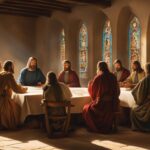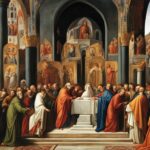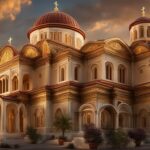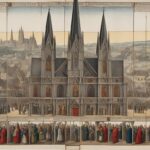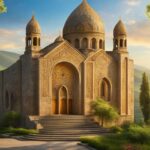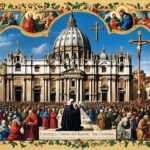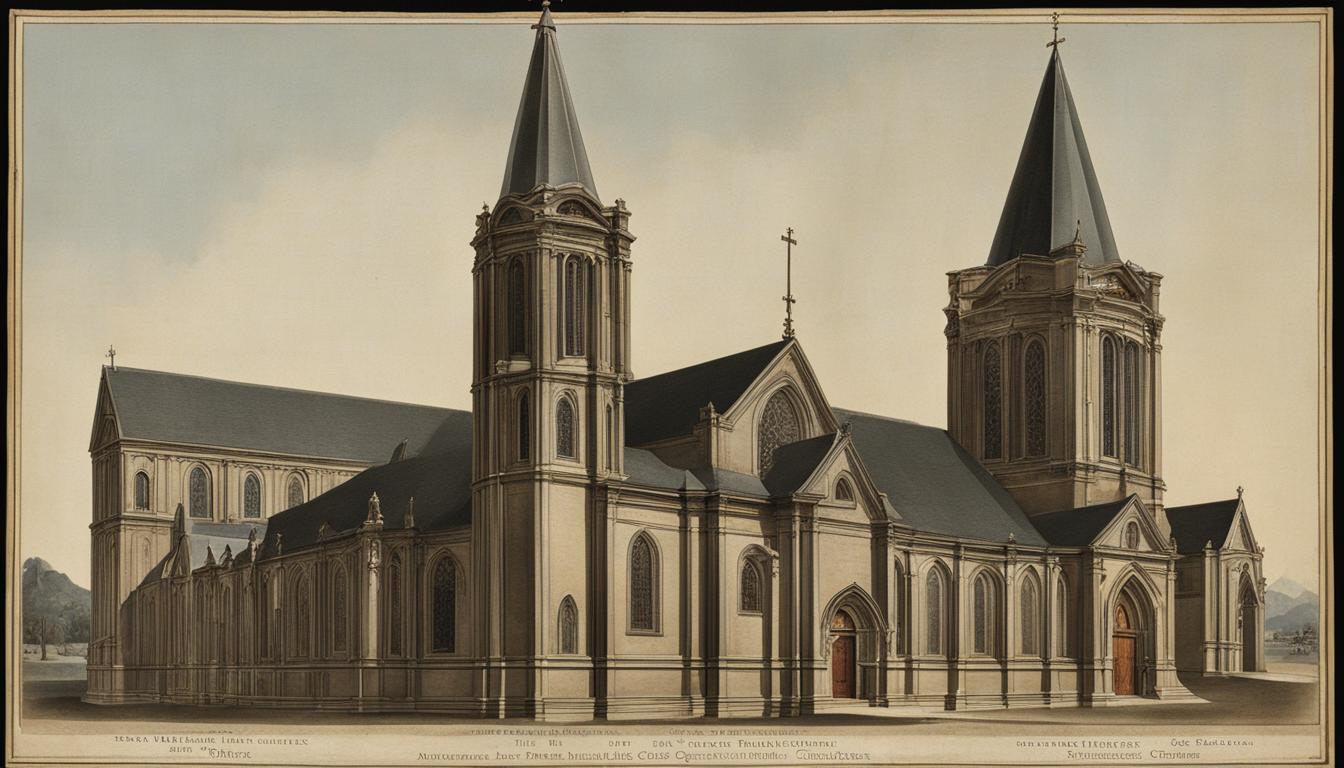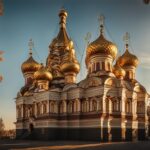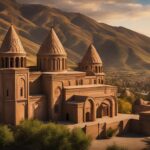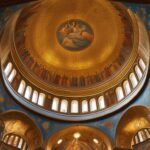The Greek Orthodox Church has a rich and inspiring history that dates back to the first century A.D. It traces its origins to the Apostolic Community established by Jesus Christ and his apostles. Throughout the centuries, the Church has faced numerous challenges, persevered through persecution, and played a significant role in the Byzantine Empire. It has also experienced the Great Schism with the Roman Catholic Church. Today, the Greek Orthodox Church stands as a testament to the enduring faith and traditions of Orthodox Christianity. (Factual data from First source:)
Key Takeaways:
- The Greek Orthodox Church has its origins in the Apostolic Community established by Jesus Christ and his apostles.
- The Church has a rich history that spans centuries and has been shaped by various events and developments.
- Throughout its existence, the Greek Orthodox Church has faced challenges, survived persecution, and played a significant role in the Byzantine Empire.
- The Church experienced the Great Schism with the Roman Catholic Church but remains steadfast in its faith and traditions.
- The Greek Orthodox Church is a testament to the enduring legacy of Orthodox Christianity and continues to inspire millions of faithful worldwide.
Beliefs and Doctrines of the Greek Orthodox Church
The Greek Orthodox Church is deeply rooted in the beliefs and doctrines of the early Christian Church. Its teachings are based on the Holy Scriptures, the traditions of the Apostolic Church, and the wisdom of the early Christian Fathers. These beliefs form the foundation of the faith followed by millions of Orthodox Christians around the world.
1. The Nicene Creed
The Greek Orthodox Church upholds the Nicene Creed as a fundamental statement of faith. This ancient creed affirms the belief in the Holy Trinity, acknowledging God the Father, God the Son (Jesus Christ), and God the Holy Spirit as three distinct yet indivisible persons. The Nicene Creed also proclaims the divinity of Jesus Christ and the truth of His incarnation, crucifixion, resurrection, and second coming.
2. Sacraments and Spiritual Life
Orthodox Christians place great importance on sacraments as outward signs of God’s grace. These sacraments include Baptism, Chrismation, the Eucharist (Holy Communion), Confession, Anointing of the Sick, Marriage, and Holy Orders. Through these sacraments, believers are united with Christ and receive spiritual nourishment and transformation.
Orthodox Christians also engage in a life of prayer, fasting, and spiritual asceticism. Prayer is considered a way to commune with God and seek His guidance and blessings. Fasting is viewed as a means of self-discipline and spiritual purification, often observed during designated periods such as Great Lent.
3. Veneration of Saints and Icons
“Icons are not idols, but windows to heaven, enabling us to experience the presence of God and the intercession of the saints.”
Greek Orthodox believers hold a deep reverence for the saints, viewing them as examples of faith and sources of intercession. Saints, both known and unknown, are commemorated and venerated for their spiritual achievements and devotion to Christ. The faithful often turn to the saints for prayers and assistance with their spiritual journeys.
Icons, sacred images depicting Christ, the Virgin Mary, and the saints, hold a central place in Orthodox worship. Icons are believed to be windows to heaven, reminding the faithful of the presence of God and His saints. They are commonly displayed in churches, homes, and places of prayer as aids to worship and sources of spiritual inspiration.
4. Holy Days and Traditions
The Greek Orthodox Church celebrates a rich calendar of holy days, commemorating significant events in the life of Christ, the Virgin Mary, and the saints. These holy days are marked by special liturgical services, fasting periods, and traditions unique to each feast. Examples include Pascha (Easter), the Dormition of the Theotokos (Assumption of the Virgin Mary), and the feast days of the patron saints of local parishes.
Orthodox Christians also observe customs and traditions that have been passed down through generations. These traditions encompass various aspects of religious life, including baptisms, weddings, funerals, and the blessing of homes and objects. They serve to connect believers with their faith, reinforce the teachings of the Church, and foster a sense of identity and continuity within the community.
Incorporating these beliefs and doctrines into their daily lives, Greek Orthodox Christians find spiritual nourishment, guidance, and a deep sense of connection to God and the Church.
Sacraments and Rituals in the Greek Orthodox Church
The Greek Orthodox Church, deeply rooted in its ancient traditions, upholds the significance of sacraments and rituals in the spiritual lives of its followers. These sacred practices serve as transformative moments, conveying the grace and presence of God to Orthodox Christians.
The Church recognizes seven sacraments that hold immense importance within its doctrine. These include:
- Baptism: The initiation into the Christian faith, symbolizing spiritual rebirth and incorporation into the Church community.
- Chrismation: The anointing with holy chrism, signifying the reception of the Holy Spirit and the sealing of the believer as a child of God.
- Eucharist: The Holy Communion, where the faithful partake in the body and blood of Christ, uniting them with Him and each other.
- Confession: The act of repentance and the sacrament of reconciliation, allowing for the forgiveness of sins through the guidance of a priest.
- Anointing of the Sick: The anointing of the ill or suffering, accompanied by prayers for healing and spiritual strength.
- Marriage: The sacrament of holy matrimony, uniting a man and a woman in a lifelong commitment blessed by the Church.
- Ordination: The sacrament through which individuals are ordained as deacons, priests, or bishops, enabling them to serve the Church and its faithful.
These sacraments are regarded as transformative moments of divine grace, nurturing spiritual growth and fostering a deeper connection with God.
Beyond the sacraments, the Greek Orthodox Church encompasses rich and elaborate rituals during various occasions, with the Divine Liturgy standing as the primary worship service. During the Divine Liturgy, the faithful gather in reverence and participate in the sacred rituals that have been practiced for centuries.

Incense fills the air, creating an atmosphere of spirituality and cleansing. Chanting resonates, enveloping the congregation in melodies that transcend time. Candles flicker, symbolizing the light of Christ’s presence. These elements combine to create a truly awe-inspiring and captivating experience as Orthodox Christians engage in worship.
The rituals and traditions of the Greek Orthodox Church serve as a gateway to a deeper spiritual understanding, inviting believers to participate fully in the ancient mysteries and embrace the grace and love of God.
Leadership and Clergy in the Greek Orthodox Church
The Greek Orthodox Church operates under a hierarchical structure with various levels of leadership. At the top of this structure is the Ecumenical Patriarch of Constantinople, who holds the esteemed position of being the “first among equals” in the Eastern Orthodox Church.
Below the Ecumenical Patriarch, there are patriarchs, metropolitans, archbishops, and bishops who oversee different regions and dioceses. These leaders are responsible for providing spiritual guidance, overseeing the administration of the Church, and ensuring the preservation of Orthodox Christian traditions.
The clergy within the Greek Orthodox Church can be both married and celibate. Priests play a vital role in the day-to-day operations of the Church, conducting worship services, administering sacraments, and offering pastoral care to the faithful.
The clergy are seen as spiritual shepherds, guiding the members of the Church in their spiritual journeys and helping them grow in their relationship with God. They are also involved in teaching and educating the community about the beliefs and practices of the Greek Orthodox Church.
Through their leadership and devotion, the clergy of the Greek Orthodox Church play an essential role in fostering a strong and vibrant community of Orthodox Christians.
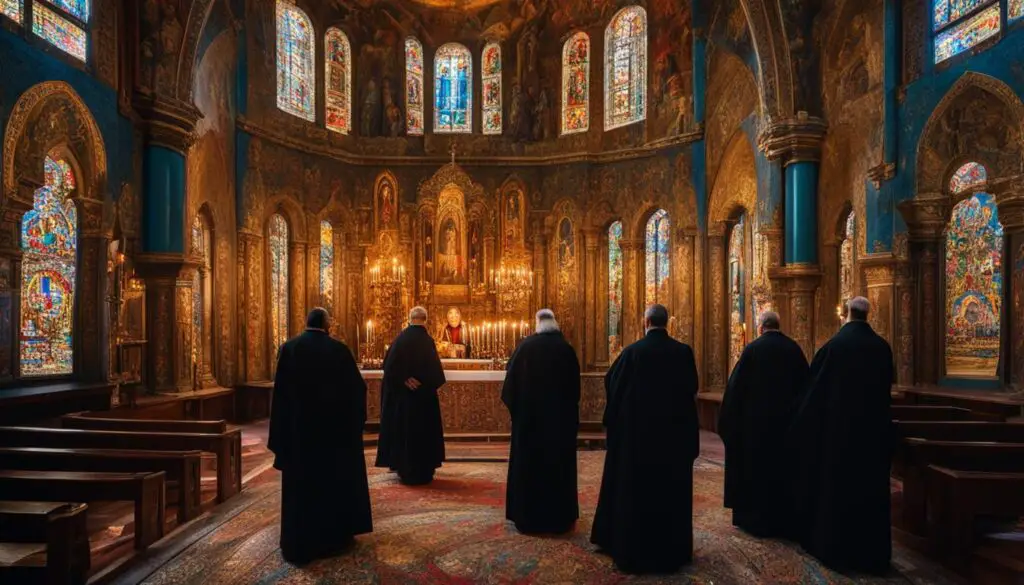
The Role of the Clergy
In the Greek Orthodox Church, the clergy serve as spiritual guides and facilitators of the sacraments. They are entrusted with the responsibility of nurturing the spiritual growth of the faithful, providing pastoral care, and leading the community in worship.
Different Levels of Clergy
| Position | Role |
|---|---|
| Patriarch | The highest-ranking bishop who presides over a specific region or jurisdiction. |
| Metropolitan | An archbishop who oversees an ecclesiastical province or a significant metropolitan area. |
| Archbishop | A bishop who has authority over a particular diocese or archdiocese. |
| Bishop | A clerical rank below the status of archbishop, responsible for overseeing a smaller territorial jurisdiction. |
| Priest | An ordained minister who leads worship services, administers sacraments, and provides spiritual guidance to the members of the Church. |
The Greek Orthodox Church values the leadership and guidance provided by its clergy. Their dedication to the faith and their commitment to the well-being of the community contribute to the thriving spiritual life of the Greek Orthodox Church.
Worship Practices in the Greek Orthodox Church
The Greek Orthodox Church embraces worship as a sacred and integral part of the faith, encompassing a rich tapestry of liturgical prayers, hymns, and rituals. At the heart of this worship experience is the Divine Liturgy, a profound and transformative service in which the Eucharist is celebrated. Through active participation, the congregation engages in prayer, singing, and making the sign of the cross, immersing themselves in the beauty and reverence of Orthodox worship.
Central to the worship practices of the Greek Orthodox Church is the use of icons, incense, and liturgical vestments, symbolizing the connection between the earthly and heavenly realms. Icons, sacred images of Christ, the Virgin Mary, and the saints, serve as windows to the spiritual world, inviting worshipers into a deeper experience of divine presence. The fragrant aroma of incense fills the air, carrying prayers heavenward, while the clergy’s resplendent vestments visually embody their sacred calling.
In addition to the Divine Liturgy, the Greek Orthodox Church incorporates a diverse array of prayers and rituals into its worship services. These include the Great Vespers, Orthros, and various services commemorating important feasts and holy days. The use of chant, a powerful and melodic form of worship sung by clergy and congregants, adds a distinct layer of spiritual depth and unity.
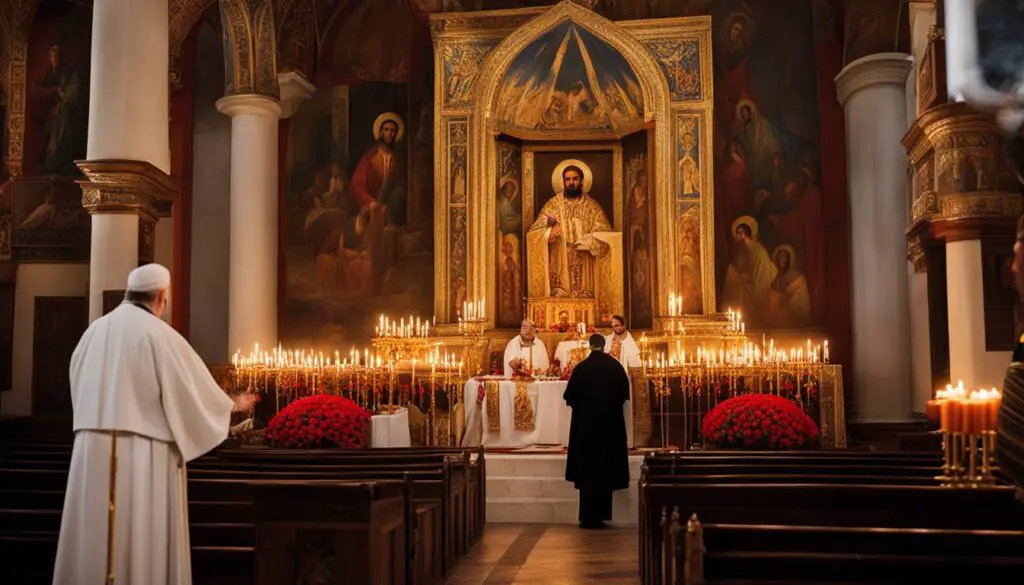
“The Greek Orthodox Church’s worship practices are a harmonious blend of ancient traditions woven with deep spiritual significance. Through iconography, incense, and vestments, our worship experience becomes a visual symphony connecting us to the divine.”
Overview of Worship Practices:
| Key Elements | Significance |
|---|---|
| Divine Liturgy | The central worship service where the Eucharist is celebrated, uniting the faithful with Christ. |
| Icons | Sacred images that serve as windows to the spiritual realm, inviting worshipers into a deeper experience of divine presence. |
| Incense | The fragrant aroma symbolizes the prayers of the faithful rising to heaven, creating an atmosphere of reverence. |
| Liturgical Vestments | The beautifully adorned garments worn by clergy reflect their sacred calling and contribute to the overall visual grandeur of worship. |
| Chant | The melodic prayers and hymns sung by clergy and congregants enhance the spiritual atmosphere and foster a sense of unity. |
Through its worship practices, the Greek Orthodox Church seeks to cultivate a transformative encounter with the divine, drawing individuals into a deeper relationship with God and fostering a sense of awe and reverence. These practices serve as vehicles for spiritual growth and provide a sacred space for worshipers to experience the presence of the Holy Spirit.
Sacred Texts of the Greek Orthodox Church
In the Greek Orthodox Church, the sacred texts hold immense significance as they provide the foundation for the faith and teachings of the Church. The primary sacred text of the Greek Orthodox Church is the Bible, which includes both the Old Testament and the New Testament.
The Old Testament consists of the sacred scriptures of Judaism, including the books of Genesis, Exodus, Psalms, and others. These texts recount the history, laws, prophecies, and wisdom of the Jewish people and serve as a testament to God’s covenant with His chosen people.
The New Testament, on the other hand, focuses on the life, teachings, death, and resurrection of Jesus Christ, as well as the early Christian community and the apostles. It includes the four Gospels of Matthew, Mark, Luke, and John, as well as the Acts of the Apostles, the Epistles, and the Book of Revelation.
Within the Greek Orthodox Church, the Bible is not interpreted based solely on individual understanding but is read and understood in the context of the Church’s teachings and traditions. The Church emphasizes the guidance and illumination of the Holy Spirit when interpreting the sacred texts.
“The Bible is not a mere historical document or collection of moral lessons, but the living Word of God – divinely inspired and relevant for all generations.”
In addition to the Bible, the Greek Orthodox Church values the writings of the early Church Fathers, who were influential theologians and spiritual leaders in the early centuries of Christianity. These writings provide insight, interpretation, and commentary on the scriptures and serve as a valuable resource for understanding the Orthodox faith.
Various theological texts, treatises, and commentaries are also highly regarded within the Greek Orthodox Church. These texts help to elucidate and articulate the beliefs, doctrines, and practices of the Orthodox faith, offering guidance to both clergy and laity.
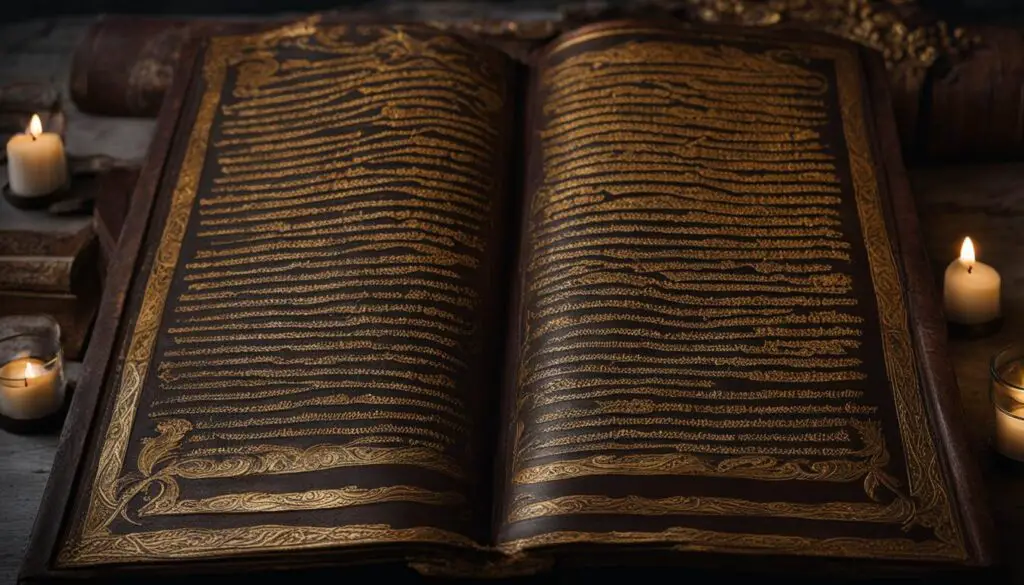
Denominations and Sects within the Greek Orthodox Church
While the term “Greek Orthodox Church” generally refers to the Eastern Orthodox Church as a whole, there are also independent churches and denominations within the Orthodox communion that retain the use of the Greek language in their liturgical practices. These include the Church of Greece, the Greek Orthodox Archdiocese of America, and the Greek Orthodox Church of Alexandria, among others. Each of these entities has its own leadership and administration, but all share a common faith and spiritual heritage.
The Church of Greece is the largest autocephalous (self-governing) Orthodox Church in Greece and plays a significant role in the religious life of the country. It is led by the Archbishop of Athens and All Greece.
The Greek Orthodox Archdiocese of America is the largest Orthodox Christian organization in the United States. It operates under the jurisdiction of the Ecumenical Patriarchate of Constantinople and is headed by the Archbishop of America.
The Greek Orthodox Church of Alexandria is one of the oldest Christian communities in Africa. It is led by the Pope and Patriarch of Alexandria and All Africa.
These denominations and sects within the Greek Orthodox Church contribute to the richness and diversity of Orthodox Christianity, while maintaining a shared commitment to the core beliefs and traditions of the faith.
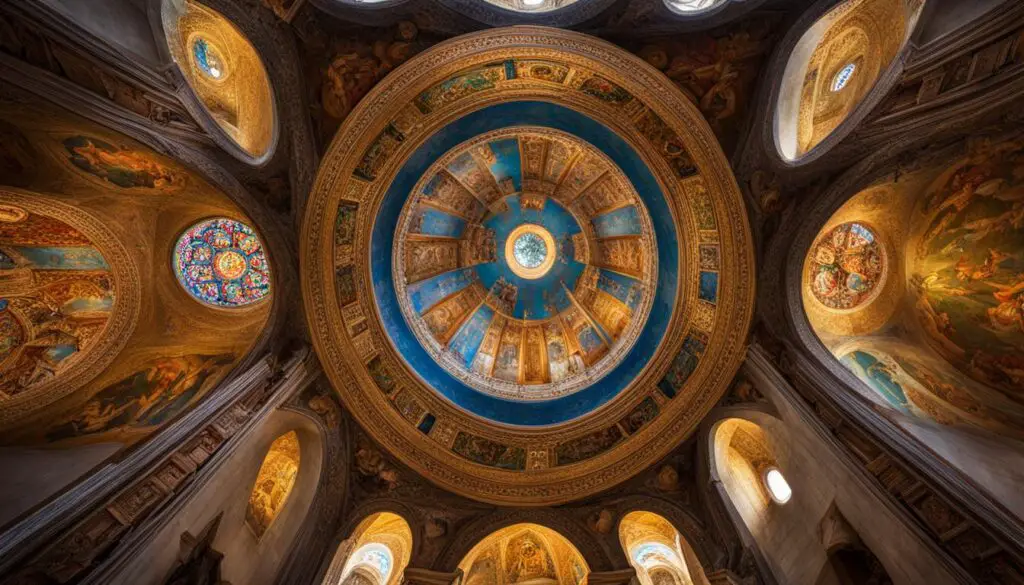
| Denomination/Sect | Head | Location |
|---|---|---|
| Church of Greece | Archbishop of Athens and All Greece | Greece |
| Greek Orthodox Archdiocese of America | Archbishop of America | United States |
| Greek Orthodox Church of Alexandria | Pope and Patriarch of Alexandria and All Africa | Africa |
| … | … | … |
Community and Outreach in the Greek Orthodox Church
The Greek Orthodox Church is not just a religious institution; it is a vibrant community dedicated to making a positive difference in the world. Community outreach plays a fundamental role in the Church’s mission, as it strives to support and uplift individuals and communities in need.
The Church engages in various charitable activities, offering assistance to those facing hardships and providing aid to vulnerable populations. Through social services, the Greek Orthodox Church addresses societal challenges such as poverty, homelessness, and hunger. These programs aim to improve the well-being and quality of life for those in need, embodying the teachings of compassion and service found in Orthodox Christianity.
Education is another key aspect of the Greek Orthodox Church’s outreach efforts. The Church actively promotes learning and education through initiatives such as schools, literacy programs, and scholarships. By investing in education, the Church empowers individuals and communities, fostering personal growth and creating opportunities for a brighter future.
To foster fellowship and unity among its members, the Greek Orthodox Church organizes events and gatherings that bring individuals together in celebration, worship, and shared experiences. These occasions strengthen social bonds, deepen spiritual connections, and reinforce a sense of belonging within the Church community.
Furthermore, Orthodox Christians are encouraged to live out their faith through acts of love, mercy, and justice. This call to action extends beyond the walls of the Church and into the wider world. Orthodox believers are inspired to make a positive impact in their local communities and beyond, spreading kindness, compassion, and justice in their interactions with others.
“Let us not speak without deeds, nor believe without experience, nor doubt without investigation, nor deny without reason, but let us first examine and then speak, while we are also prepared to act.” – St. John Chrysostom
This quote from St. John Chrysostom emphasizes the importance of translating faith into action. The Greek Orthodox Church seeks to embody these values, actively engaging in acts of love and service that reflect the teachings of Christ.
The Greek Orthodox Church’s commitment to community and outreach is a testament to its desire to make a positive impact in the lives of others. Through acts of charity, social services, educational initiatives, and fostering a sense of fellowship, the Church remains a source of support, inspiration, and hope for individuals and communities alike.
Architectural and Artistic Features of Greek Orthodox Churches
Greek Orthodox churches are renowned for their distinctive architectural style and exquisite artistic features. These architectural marvels exhibit a blend of Byzantine, Roman, and Ottoman influences, creating a unique visual identity that captivates the senses.
Traditional Greek Orthodox church buildings often feature domes that symbolize the heavens and the divine presence. The domes are intricately decorated and serve as a visual representation of the celestial realm within the earthly sanctuary.
Another prominent architectural element in Greek Orthodox churches is the iconostasis, a magnificent icon screen that separates the sanctuary from the nave. This ornate structure serves as a gateway to the holiest part of the church and is adorned with beautifully crafted icons depicting Christ, the Virgin Mary, and various saints.
“The iconostasis is not merely a physical barrier; it is a symbolic representation of the boundary between the earthly and the heavenly realms.” – Iconography and Symbolism in Greek Orthodox Churches
The interior of Greek Orthodox churches is adorned with exquisite decorations, including icons, frescoes, and mosaics. These artistic masterpieces depict scenes from the Bible, the lives of saints, and key events in Christian history. The vibrant colors and intricate details of these artworks evoke a sense of awe and reverence in worshippers.
Architectural and Artistic Features
| Feature | Description |
|---|---|
| Domes | Symbolize the divine presence and serve as visual representations of the heavens. |
| Iconostasis | Elaborate icon screen that separates the sanctuary from the nave, adorned with sacred icons. |
| Icons | Sacred images of Christ, the Virgin Mary, and saints, displayed throughout the church. |
| Frescoes | Paintings on the walls and ceilings, depicting biblical scenes and the lives of saints. |
| Mosaics | Artistic compositions created using intricate arrangements of small colored glass or stone pieces. |
The architectural and artistic features of Greek Orthodox churches serve as a testament to the devotion, faith, and artistic abilities of the community. They create a sacred space that inspires worshippers and invites them to connect with the divine in a profound and spiritual way.
Contemporary Issues and Challenges Faced by the Greek Orthodox Church
The Greek Orthodox Church, like other religious institutions, faces various challenges and issues in the modern world. These include the impact of secularization, declining church attendance, changing societal values, and the need to adapt to new technologies. The Church also grapples with issues related to religious freedom, human rights, and social justice.
“It is through the challenges we face that we have the opportunity to strengthen our faith and find new ways to connect with the ever-changing world.”
The impact of secularization poses a significant challenge to the Greek Orthodox Church. In an increasingly secular society, traditional religious beliefs and practices may be questioned or dismissed. This presents an opportunity for the Church to engage in meaningful dialogue and address misconceptions about the role of religion in contemporary life.
Another contemporary issue is declining church attendance. As societal values and priorities shift, fewer people may actively participate in religious activities. It becomes essential for the Church to find innovative ways to engage the younger generation and connect with individuals seeking spiritual guidance in non-traditional ways.
“We must adapt to the changing times without compromising our core teachings and beliefs.”
The rapid advancement of technology also poses unique challenges. While technology offers new avenues for communication and outreach, it can also create distractions and disconnect individuals from meaningful spiritual experiences. The Greek Orthodox Church strives to weave technology into its practices while emphasizing the importance of personal connection and prayer.
Religious freedom, human rights, and social justice are vital concerns for the Greek Orthodox Church. It is committed to advocating for the rights of all individuals and addressing social issues such as poverty, inequality, and discrimination. The Church aims to be a source of comfort and support to those in need, working towards a more just and compassionate society.
“We must live out the teachings of Christ by actively working for justice, extending compassion to all, and advocating for the marginalized.”
Efforts are being made within the Greek Orthodox Church to address these contemporary issues while remaining faithful to the core teachings and traditions of Orthodox Christianity. By engaging in open dialogue, embracing technological advancements, and actively participating in social issues, the Church strives to connect with individuals and communities, fostering a sense of belonging and providing spiritual guidance in the face of modern challenges.
Table: Challenges Faced by the Greek Orthodox Church
| Challenge | Impact | Potential Solutions |
|---|---|---|
| Secularization | Questioning of religious beliefs and practices | Engage in meaningful dialogue and address misconceptions |
| Declining church attendance | Shift in societal values and priorities | Find innovative ways to engage younger generations |
| Technology | Distraction and disconnection from spiritual experiences | Weave technology into practices while emphasizing personal connection and prayer |
| Religious freedom, human rights, and social justice | Advocating for rights and addressing social issues | Work towards a more just and compassionate society |
Conclusion
The Greek Orthodox Church stands as a timeless institution with a remarkable history that has shaped the lives of millions of Orthodox Christians worldwide. Through centuries of persecution, schisms, and societal changes, the Church has remained a steadfast source of spiritual guidance, community, and inspiration.
Rooted in its commitment to preserving the traditions of the early Christian Church, the Greek Orthodox Church upholds a distinct set of beliefs and doctrines. Its sacraments and rituals, such as baptism, Eucharist, and confession, serve as essential means of conveying the grace of God to the faithful.
The Church’s leadership, including patriarchs, metropolitans, and bishops, together with the dedicated clergy, play a vital role in guiding the faithful and administering the life of the Church. With the Divine Liturgy as the pinnacle of its worship practices, the Greek Orthodox Church invites active participation from its congregants, fostering a sense of unity and devotion.
Rich in sacred texts, the Greek Orthodox Church looks to the Bible and the writings of the early Church Fathers for spiritual guidance and inspiration. As a diverse spiritual community, the Church encompasses various denominations and sects, each with its unique traditions and contributions to the Greek Orthodox tradition.
The Greek Orthodox Church embraces its role as a community-centered institution, actively engaging in outreach and charitable activities. By emphasizing love, mercy, and justice, the Church seeks to make a positive impact on individuals and society at large.
Adorned with exquisite architectural and artistic features, Greek Orthodox churches serve as majestic spaces that inspire the faithful. The use of icons, frescoes, and mosaics creates an atmosphere of reverence and allows worshippers to connect with the spiritual realm.
While the Church faces contemporary challenges, such as secularization, declining attendance, and societal shifts, its unwavering commitment to its timeless faith and the enduring legacy of the Greek Orthodox tradition continues to guide its path forward.
In conclusion, the Greek Orthodox Church is an enduring beacon of spirituality, community, and tradition. It serves as a testament to the rich history of Orthodox Christianity and offers a source of inspiration and guidance to Orthodox Christians everywhere.
FAQ
What is the history of the Greek Orthodox Church?
The Greek Orthodox Church has its origins in the Apostolic Community established by Jesus Christ and his apostles. It has a rich history that dates back to the first century A.D. and has been shaped by various events and developments over the centuries, including periods of persecution, the Byzantine Empire, the Great Schism with the Roman Catholic Church, and ongoing challenges.
What are the beliefs and doctrines of the Greek Orthodox Church?
The Greek Orthodox Church upholds the Nicene Creed, which declares belief in the Holy Trinity, the divinity of Jesus Christ, and the resurrection of the dead. It places a strong emphasis on sacraments, prayer, fasting, and the veneration of saints. It also maintains traditions and customs that have been passed down through generations.
What are the sacraments and rituals in the Greek Orthodox Church?
The Greek Orthodox Church recognizes seven sacraments, including baptism, chrismation, Eucharist, confession, anointing of the sick, marriage, and ordination. These sacraments are considered central to the spiritual life of Orthodox Christians and are believed to convey the grace of God. The Church also has rich and elaborate rituals for various occasions, such as the Divine Liturgy, which is the primary worship service.
Who are the leaders and clergy in the Greek Orthodox Church?
The Greek Orthodox Church is led by a hierarchical structure that includes patriarchs, metropolitans, archbishops, and bishops. The Ecumenical Patriarch of Constantinople holds a special position as the “first among equals” in the Eastern Orthodox Church. The clergy of the Church can be both married and celibate, and they play a vital role in the spiritual guidance and administration of the Church.
What are the worship practices in the Greek Orthodox Church?
Worship in the Greek Orthodox Church is characterized by a combination of liturgical prayers, hymns, and rituals. The Divine Liturgy is the central worship service, in which the Eucharist is celebrated. The Church places great importance on the participation of the congregation through active engagement in prayer, singing, and making the sign of the cross. The use of icons, incense, and liturgical vestments also adds to the beauty and reverence of Orthodox worship.
What are the sacred texts of the Greek Orthodox Church?
The Greek Orthodox Church considers the Bible as its primary sacred text, including the Old Testament and the New Testament. These texts are read and interpreted in the context of the Church’s teachings and traditions. The Church also values the writings of the early Church Fathers and various theological texts that provide guidance and insight into the Orthodox faith.
Are there denominations and sects within the Greek Orthodox Church?
While the term “Greek Orthodox Church” generally refers to the Eastern Orthodox Church as a whole, there are also independent churches and denominations within the Orthodox communion that retain the use of the Greek language in their liturgical practices. These include the Church of Greece, the Greek Orthodox Archdiocese of America, and the Greek Orthodox Church of Alexandria, among others.
What community and outreach efforts does the Greek Orthodox Church engage in?
The Greek Orthodox Church places a strong emphasis on community and outreach. It is involved in various charitable activities, social services, and educational programs that aim to support and uplift individuals and communities. The Church also organizes events and gatherings that foster a sense of fellowship and unity among its members. Orthodox Christians are encouraged to actively engage in acts of love, mercy, and justice in the world.
What are the architectural and artistic features of Greek Orthodox churches?
Greek Orthodox churches are known for their distinctive architectural style and artistic features. Traditional church buildings often have domes, iconostases (icon screens), and elaborate interior decorations, including icons, frescoes, and mosaics. The icons, which are sacred images of Christ, the Virgin Mary, and the saints, hold a significant place in Orthodox worship and are considered windows to the spiritual realm.
What are the contemporary issues and challenges faced by the Greek Orthodox Church?
The Greek Orthodox Church, like other religious institutions, faces various challenges and issues in the modern world, including secularization, declining church attendance, changing societal values, and the need to adapt to new technologies. The Church also grapples with issues related to religious freedom, human rights, and social justice. Efforts are being made to address these challenges while remaining faithful to the core teachings and traditions of Orthodox Christianity.

